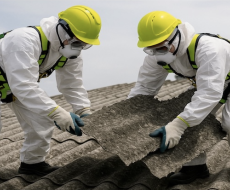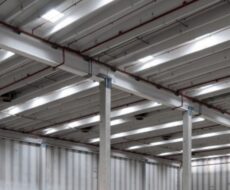
August 4, 2025
Seveso & NaTech: why seismic retrofit is strategic for Major-Accident Hazard (MAH) establishments
At sites governed by the Seveso Directive—classified in Italy as Rischio di Incidente Rilevante (RIR, i.e. Major-Accident Hazard establishments)—seismic strengthening is not merely a “nice-to-have”, but a statutory duty. The combination of hazardous substances, a high concentration of personnel and the potential for explosions or toxic releases—together with earthquake exposure—demands targeted structural interventions.
Upgrading plant structures means:
- Preventing environmental disasters and safeguarding the health of workers and neighbouring communities.
- Maintaining operational continuity after an earthquake, minimising damage and downtime.
- Achieving full compliance with Seveso obligations and NaTech guidelines, thereby avoiding penalties and protecting corporate reputation.
Legislative framework: Italian Legislative Decree 105/2015 (Seveso III)
Legislative Decree 105/2015—implementing Directive 2012/18/EU—aims to prevent major accidents involving dangerous substances and to limit their consequences for:
- Human health
- The environment
- Material assets (including cultural heritage and infrastructure)
Industrial establishments subject to Legislative Decree 105/2015 handle hazardous substances in quantities that can generate major accidents. In Italy, these sites fall into Use Class IV under the 2018 Technical Standards for Construction (NTC 2018): they must therefore ensure a higher level of seismic safety than that required for ordinary buildings. The reason is clear: an earthquake can trigger, worsen, or prevent the containment of an accident — the so-called earthquake-related NaTech risk (Natural Hazards Triggering Technological Disasters). (UNI/TS 11816-1:2021 standard “Guidelines for the management of NaTech events within establishments with a major-accident hazard”).
In this scenario, seismic retrofitting and upgrading are not mere technical options, but legal obligations and opportunities to protect people, the environment, and business continuity.
Seveso and seismic risk: what the law says
I. Legislative Decree 105/2015 (Seveso III legislation)
Legislative Decree 105/2015: requires the operator to prevent major accidents and to assess natural events (earthquakes included) in the Safety Report.
Legislative Decree 105/2015, which transposes Directive 2012/18/EU on the control of major-accident hazards involving certain dangerous substances, classifies as major-accident hazard (RIR) establishments those plants in which a large-scale release, fire or explosion — due to uncontrolled developments — may pose a serious, immediate or delayed danger to human health or the environment, inside or outside the establishment, in the presence of one or more dangerous substances.
Legislative Decree 105/15 requires, for all establishments within its scope, the preparation of a safety analysis which, in identifying hazards and assessing major-accident risks, also takes natural events into account.
Summary of the main definitions in Legislative Decree 105/2015
Establishment — The entire area under an operator’s control where dangerous substances are present in one or more installations, including related infrastructure and activities.
Installation — A technical unit (above or below ground) within the establishment in which dangerous substances are produced, used, handled or stored; includes all equipment and structures needed for its operation (tanks, pipelines, jetties, warehouses, etc.).
Operator — A natural or legal person who owns/operates the establishment or installation, or who has delegated decision-making and financial authority for its technical operation.
Major accident — An event (large-scale release, fire or explosion) due to uncontrolled developments that poses a serious, immediate or delayed danger to human health or the environment, inside or outside the establishment, involving one or more dangerous substances.
Domino effect — A sequence of major accidents, possibly of different types, that are inter-related and affect installations in one or more establishments, generating direct or indirect, immediate or delayed effects (inter-establishment scenario).
Regional Technical Committee (RTC) — A collegiate body chaired by the Regional Fire Service Director, composed of technical agencies (Fire Service, ARPA, INAIL, Region, Local Health Authority, etc.), which reviews and approves Safety Reports for upper-tier establishments.
What are the operator’s general duties? (Art. 12)
The operator must adopt all suitable measures to prevent major accidents and to limit their consequences for human health and the environment. In addition, the operator must be able, at any time, to demonstrate to the competent and supervisory authorities—particularly for the purposes of inspections and audits—the adoption of all measures required by this Legislative Decree.
What to know about the Safety Report? (Art. 15)
Below is a concise summary of the safety report:
• Obligation
The operator of an upper-tier establishment must draft and submit a Safety Report.
• Purpose of the document
- Demonstrate the implementation of a major-accident prevention policy and an adequate safety management system.
- Describe hazards, risk scenarios, prevention/mitigation measures, and potential consequences (including off-site).
- Provide the authorities with the elements needed for land-use planning and civil protection.
• Timing
• New establishments: before start-up.
• Significant modifications: within 12 months.
• Periodic update: at least every 5 years or when substantial changes / new data arise.
• Submission
The report must be sent to:
• Ministry of the Environment and Energy Security (MASE)
• Regional Technical Committee (CTR)
• Prefect (emergency planning)
• Competent Region and Municipality.
• Assessment
The CTR reviews the report, may request additions, carry out inspections, and verify the safety management system. Operations may proceed only after a positive outcome.
• Annex C
Provides the technical-engineering criteria to draft/review the report; among these: precautions and safety factors adopted (including seismic actions) for structures, critical components, and control rooms.
What is the difference between the Operator and the Employer?
In companies subject to the Seveso legislation, the Operator and the Employer often coincide within the same legal entity, but they fall under two different regulatory frameworks that must be coherently integrated into risk management.
Comparative summary of the two roles
| Aspect | Operator (Seveso) | Employer (D.Lgs. 81/2008) |
|---|---|---|
| Definition | The entity that operates or controls a major-accident-hazard installation. | The person who holds the employment relationship or is responsible for the company’s organisation. |
| Reference legislation | D.Lgs. 105/2015 | D.Lgs. 81/2008 |
| Responsibilities | Ensure installation safety; prevent major accidents; prepare the Safety Report and the Internal Emergency Plan (PEI). | Ensure workers’ safety; draw up the Risk Assessment Document (DVR); train and inform. |
| Common obligations | Major-accident risk assessment; PEI/Emergency Plan; notifications/communications to authorities (public administration, population). | Assessment of all occupational risks; appoint the H&S manager (RSPP); emergency management and occupational health surveillance. |
| Role in NaTech risk | Integrate natural hazards into industrial risk analyses (e.g., earthquakes, floods). | Consider external events relevant to workers’ safety. |
II. O.P.C.M. no. 3274 of 20 March 2003
What does Art. 2 paragraph 3 say?
It requires the respective owners to carry out a verification, in accordance with the standards set out in the aforementioned annexes, both for buildings of strategic interest and for infrastructure whose functionality during seismic events is of fundamental importance for civil protection purposes, and for buildings and infrastructure that may be relevant in relation to the consequences of a possible collapse.
III. Consolidated text of Annex 2 – Buildings – to Ordinance 3274 as amended by OPCM 3431 of 03/05/05
What are the technical rules for the design, assessment and seismic upgrading of buildings?
Structures must be provided with a level of seismic protection differentiated according to their importance and use, and therefore according to the more or less serious consequences of damage caused by an earthquake.
For this purpose, different “importance categories” are established, each associated with a factor γI, called the importance factor (see Consolidated text of Annex 2 – Buildings – to Ordinance 3274 as amended by OPCM 3431 of 3/5/05, point 4.7). This factor amplifies the intensity of the design seismic action with respect to the value assumed for ordinary-importance constructions (reference seismic action).
IV. NTC 2018 and Circular No. 7 of 21 January 2019 of the Superior Council of Public Works
Circular No. 7/2019 of the Superior Council of Public Works provides operational guidance for applying the new 2018 Technical Standards for Construction (Ministerial Decree of 17 January 2018), replacing the previous Circular 617/2009 linked to the 2008 NTC. The document offers clarifications and practical instructions—aimed mainly at designers and sector professionals—to ensure correct and uniform application of the updated provisions.
In particular, Use Class IV includes industries with activities that are especially hazardous for the environment, including those subject to Legislative Decree 105/2015, confirming that such facilities fall among the strategic constructions classified as Class IV.
It specifies that other use classes may be adopted only for parts of a facility that do not affect the initiation, development, or mitigation of a major accident, or are not involved in primary incident scenarios, seismic or otherwise.
It also emphasizes that, as the use class and nominal life increase, the reference period for seismic design grows, and the design peak ground acceleration (PGA) increases accordingly.
Earthquake-related NaTech risk for establishments subject to Legislative Decree 105/2015
What is NaTech risk and what are the Operator’s responsibilities?
The term NaTech (Natural Hazards Triggering Technological Disasters) refers to technological accidents—fires, explosions, toxic releases—that can occur in industrial plants or distribution networks when natural disasters strike. For Major-Accident Hazard (MAH) establishments, assessing these effects requires a systemic, multidisciplinary approach that considers both process equipment and structural aspects.
Legislative Decree 105/2015 incorporates this concept: it recognises that natural events (e.g., earthquakes) can trigger major accidents and requires the NaTech analysis to be integrated into the prevention process through appropriate technical, managerial/organisational and information measures.
The Operator has the formal obligation to assess earthquake-related NaTech risk, as an external event that can trigger, exacerbate, or hinder the containment of a major accident.
Below is a concise outline of the key logical steps for setting up the assessment and management of earthquake-related NaTech risk:
After the safety checks, the operator and the engineer must define a time-phased intervention plan that reflects the identified priorities: the higher the level of inadequacy or the intrinsic hazard of the element, the shorter the timeframe for seismic retrofitting or upgrading must be. If the analysis highlights accident scenarios of particular severity, action should be taken as soon as possible, also adopting compensatory measures (technical, managerial, restrictions on use) to contain the risk.
For existing facilities, NTC 2018, Ch. 8 applies: the safety level is measured with the ratio ζE.
• Seismic retrofitting: target ζE ≥ 0.80.
• Seismic improvement: permitted only when 0.80 cannot be achieved for technical/economic reasons; it still requires ζE ≥ 0.60 and the adoption of technical and managerial mitigation systems.
Major-Accident Hazard establishments – safety management systems – guidelines for the application of UNI 10617
UNI 10617 defines the Safety Management System for establishments classified as Major-Accident Hazard (MAH). The standard is designed to prevent fires, explosions and toxic releases associated with hazardous substances, and provides a methodological framework that guides the company through all phases: from defining the prevention policy to implementing operating procedures, through to periodic review and continuous improvement of the system. It sets out the organizational and technical requirements needed to establish, implement, maintain and enhance the Safety Management System, supplemented with examples of procedures, monitoring tools and verification criteria.
Its application covers both entire plants and individual technical units in which hazardous substances are produced, used, handled or stored. In essence, UNI 10617 is the primary reference for companies subject to the Seveso regime, providing a comprehensive framework to identify, assess and manage risks in a structured and proactive way, minimizing the likelihood and consequences of accidents.
In summary, for the application of UNI 10617 it is necessary to take into account:
• Organizational context
To build or improve the MAH Safety Management System (SGS-PIR), analyze all factors—positive and negative—that may affect the establishment’s safety objectives. Consider both internal and external elements: strategic issues, operational criticalities, and changes that could alter the operator’s ability to achieve the expected results. External factors include, for example, site environmental characteristics and natural hazards (earthquakes, floods, lightning, wildfires, local climatic conditions).
• Interactions with the context
The establishment operates within a broader system that includes environmental, social, technological, ethical, political, legal, and economic-financial dimensions. On the environmental side, assess—among many other aspects—potentially triggering natural phenomena (earthquakes, intense meteorological events, floods, landslides, wildfires) — in line with UNI/TS 11816-1 on managing earthquake-related NaTech risk — to understand how they may amplify hazards associated with the hazardous substances present.
In conclusion, for companies at major-accident risk, such as those subject to the Seveso regime, seismic-risk management is a structured journey that considers multiple regulations and factors; it is not merely a compliance task, but a strategic investment that combines safety, environmental protection, and business continuity. With over 1,000 seismic retrofits and deep expertise in Seveso and earthquake-related NaTech risk, Seriana positions itself as an ideal partner to guide each establishment through its seismic upgrading or improvement program.






